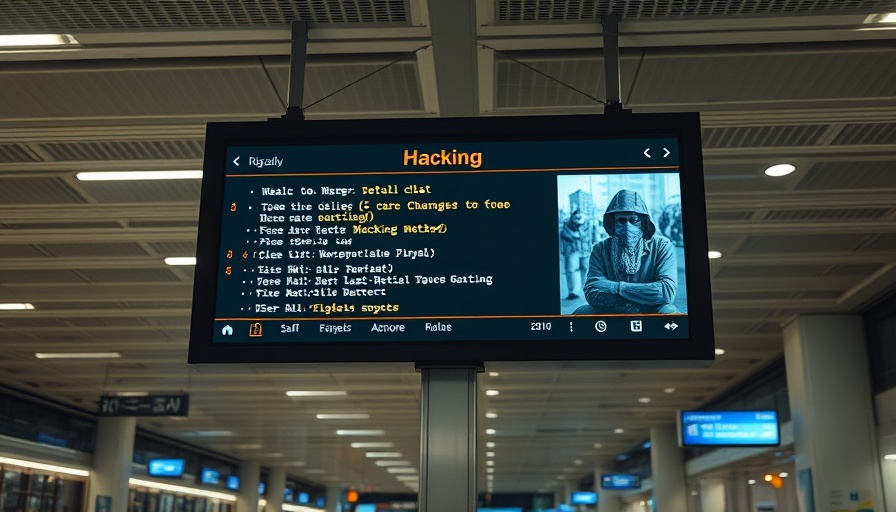
Israel Reduces Aid to Gaza Amid Ongoing Tensions with Hamas: What’s Next?


B.C. Airport Hacks Sending Pro-Hamas Messages: What It Means for Security
Update Unprecedented Security Breach at B.C. Airports In a surprising turn of events, Kelowna International Airport and Victoria International Airport experienced major security breaches on October 15, 2025, when their display screens and public address systems were hacked to broadcast pro-Hamas messages. Both airports confirmed that a third party had gained unauthorized access, leading to confusion and disruption among travelers. Details of the Incident: What Happened? During the evening, Kelowna International Airport's terminals were briefly transformed into sites of unexpected political messaging, with screens showcasing messages condemning Israel and critiquing U.S. politicians, including former President Donald Trump. This disruption not only startled passengers but also resulted in some flight delays. By the time the airport staff addressed the hack, the unauthorized messages were displayed for several minutes before being taken down. Rapid Reaction: How the Airports Responded In a swift response, the management teams at both airports acted quickly to mitigate the effects of the breach. Kelowna International noted in their statement that they had successfully removed the unauthorized messaging, restoring services, including the PA system. Victoria International Airport experienced a different version of the same incident, where its PA system was hacked, reportedly due to a “cloud-based software issue.” Staff confirmed that an unauthorized audio file played through the loudspeakers, which also raised concerns among travelers. Immediate action taken by airport teams ensured minimal disruption, with no significant delays reported. Potential Implications: A Wake-Up Call for Airport Security The implications of these incidents are substantial, not only raising significant security alarms for all airports in Canada but also extending to international standards. Transport Canada has acknowledged the breaches and is coordinating with law enforcement to evaluate the incidents' security implications. Meanwhile, experts are voicing concerns regarding the increasing sophistication of cyber threats against critical infrastructure, especially within public transport systems. The Canadian Centre for Cyber Security stated they are aware of these incidents and are actively investigating in collaboration with the affected airports. Broader Context: Global Rise in Cybersecurity Threats The hacks at the B.C. airports are part of a larger trend of digital security breaches around the world. Recently, similar incidents have occurred at airports in the United States, highlighting a growing pattern where hackers target public facilities to push political agendas. For instance, Harrisburg International Airport in Pennsylvania confirmed hackers played unauthorized messages over its PA system too. These instances highlight the potential risks associated with digital systems in public spaces, raising questions about the robustness of cybersecurity protocols employed by municipalities and transit authorities. Looking Forward: How to Enhance Airport Security In light of these events, enhancing airport cybersecurity measures becomes paramount. Solutions could range from better encryption of communications to more rigorous authentication processes for system access. Ultimately, as hackers continue to refine their tactics, airports must evolve their cybersecurity strategies to not only defend against current threats but also anticipate future ones. Coordination among federal agencies, cybersecurity experts, and airport authorities will be vital in crafting robust defenses. Conclusion: The Importance of Addressing Cybersecurity Challenges The incidents at Kelowna and Victoria International Airports serve as stark reminders of the vulnerabilities that exist within public infrastructure. As travelers, it's crucial to remain aware of how interconnected our systems have become and the responsibility airport authorities share in safeguarding our experiences. These events caution us about the need for strong cybersecurity measures and active vigilance from both authorities and travelers to ensure public safety and trust in transportation systems. Efforts must be made to address these vulnerabilities now, before they escalate and cause more significant disturbances in the future.

Understanding the Titan Sub Implosion: Faulty Engineering Exposed
Update Understanding the Titan Submersible Tragedy: What Went Wrong? The tragic implosion of the Titan submersible in June 2023, which resulted in the deaths of five individuals during an expedition to the Titanic's wreck, has raised critical questions about engineering standards in aquanaut technology. The National Transportation Safety Board (NTSB) has concluded that the incident was fundamentally rooted in faulty engineering practices and inadequate safety protocols. This report shines a light on the failures of OceanGate, the company behind the Titan, which had been pushing the boundaries of deep-sea exploration. Faulty Engineering and Inadequate Testing The NTSB's findings emphasize that the Titan's construction involved a carbon fiber composite pressure vessel that had numerous deficiencies. These flaws prevented the vessel from meeting necessary safety and durability requirements, critical for any underwater operations, especially one involving human lives. The submersible had not undergone adequate testing prior to its ill-fated final journey, leaving the crew unknowingly vulnerable to catastrophic failure. Systemic Regulatory Gaps Highlighted Both the NTSB and the earlier Coast Guard investigation revealed systemic failures within OceanGate. Critics have noted that the company displayed a concerning disregard for safety regulations, with observed "glaring disparities" between established safety protocols and actual practices. Investigators highlighted a culture of complacency within the organization, where concerns raised by employees were potentially ignored or dismissed, notably by its CEO, Stockton Rush. The Human Element: Lives Lost and Legacies Left Behind Among the victims of the Titan disaster were industry notables like Stockton Rush and Paul-Henri Nargeolet, who was often referred to as "Mr. Titanic". Their deaths underscore the human cost behind such expeditions, reminding us of the delicate balance between the pursuit of exploration and the responsibility that lies in ensuring safety. The loss has led to significant public outcry and demands for tighter regulations governing deep-sea explorations and the technologies involved. Future Directions: Addressing Safety in Deep-Sea Ventures The NTSB's report not only details the events leading to the Titan's implosion but also serves as a call to action for regulatory bodies like the Coast Guard. Recommendations have been made for the establishment of expert panels to review the safety procedures for submersibles. Such measures aim to reform the current regulations and enhance safety standards for future deep-sea explorations. The Rise of Private Exploration and Its Implications The disaster exemplifies the growing pains of the burgeoning industry of private maritime expeditions. As interest in undersea exploration increases, the imperative for stricter safety regulations becomes clear. The combination of technological advancement and increasing investor interest in adventure tourism has the potential for lucrative returns but, as the Titan tragedy illustrates, poses significant risks that must be mitigated through sound policy and oversight. Reflecting on the Journey Ahead In the wake of the Titan incident, stakeholders in the maritime and exploration industries must reflect on how best to honor the lives lost. This includes advocating for robust safety measures, improving technological standards, and fostering a culture of accountability within organizations engaged in similar ventures. The hope is that such tragedies will lead to proactive solutions that enhance safety for all explorers, and ensure the legacy of those who perished is one of progress rather than negligence. With ongoing investigations and discussions about the future of exploratory missions, it’s essential for potential adventurers, companies, and regulators to learn from past mistakes to build a safer framework for exploration. As we look to the future of deep-sea exploration, the industry must adapt, innovate, and prioritize human life above all.

Can 20 New Liquor Licenses in Union Square Rescue SF's Nightlife?
Update The Competition Dilemma: 20 New Liquor Licenses in Union Square San Francisco's downtown bar owners are facing a challenging reality as Mayor Daniel Lurie, alongside state Senator Scott Wiener, announces the release of 20 new liquor licenses in the Union Square area. While the intended goal is to revitalize the neighborhood and stimulate growth, local bar owners question what this influx of competition could mean for their already strained businesses. Struggling to Survive Post-Pandemic As the bar and restaurant industry continues its slow recovery from the pandemic fallout, many proprietors are wary of additional competition. Brian Sheehy, CEO of Future Bars, voiced concerns regarding the saturation of liquor licenses, stating, "The pie is only so big. And if we’re going to be slicing the pie into 20 more slices, many people are going to go hungry." This fundamental worry reflects a broader anxiety among business owners who have already fought hard to stay afloat during challenging times. The Promise of New Opportunities On the other side of the argument, proponents of the new licenses, including Wiener, emphasize the potential to foster a vibrant culinary and nightlife scene. "Creating new, more affordable licenses will allow new businesses to open and attract tourists and locals alike to our amazing downtown," stated Wiener. These new licenses could serve as a critical link in reviving the area’s appeal and boosting foot traffic, a crucial factor in attracting visitors and stimulating local economies. Finding the Middle Ground The views among local bar owners illustrate a balancing act between fostering new business initiatives and protecting established establishments. Some advocates argue for a cautious approach, advocating for measures that ensure current businesses won’t be harmed by the influx of newcomers. As Ben Bleiman, co-founder of Tonic Nightlife Group, noted, "the idea that there’d be a lot of new competition around them is both scary and potentially could be detrimental to them." The successful navigation of this complex landscape could define the future of the iconic district. Ultimately, the decision to issue new liquor licenses in Union Square presents a multifaceted issue for the community. It embodies the fragility and resilience of San Francisco’s hospitality sector as well as the ongoing struggle for balance in a rapidly changing economic environment. The outcomes will unfold continuously as local businesses adapt to new competition while vying for the attention of San Francisco's residents and visitors.
 Add Row
Add Row  Add
Add 

Write A Comment